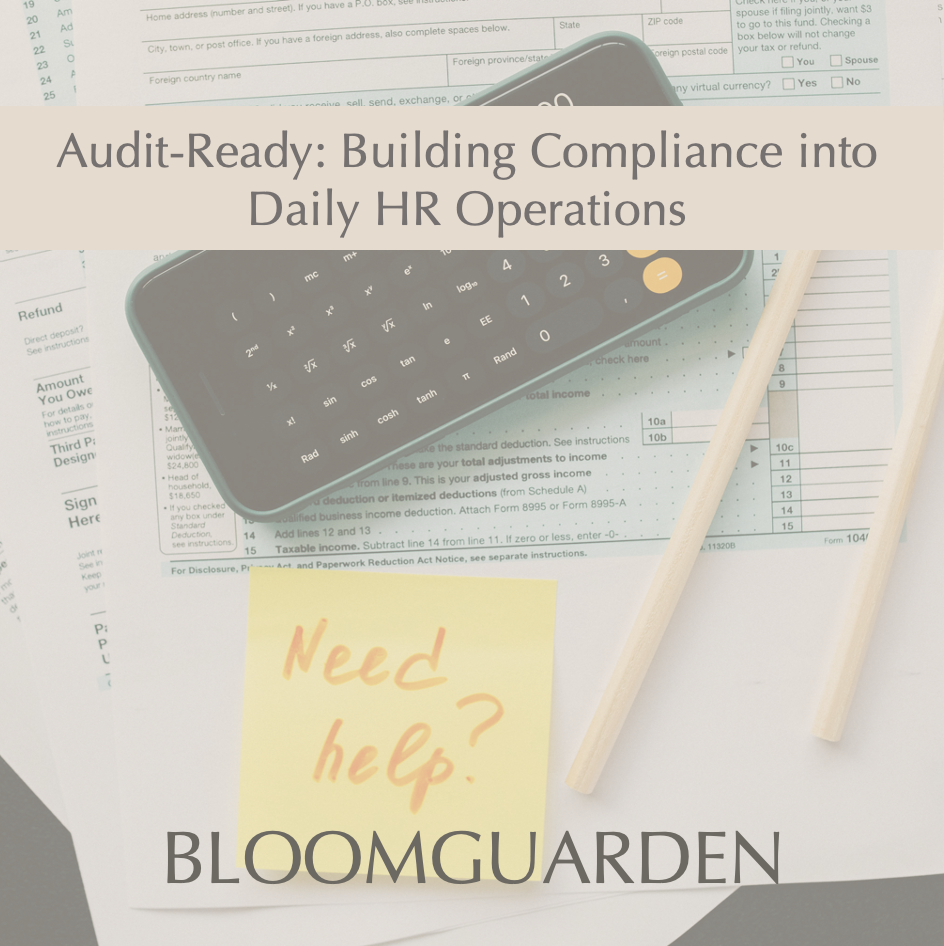Audit-Ready: Building Compliance into Daily HR Operations
For many HR teams, compliance still feels like an annual scramble—a year-end checklist pulled together in a rush before open enrollment, tax filings, or investor reporting. But in fast-scaling, multi-state, or PE-backed environments, that model doesn’t hold up. Compliance must be baked into daily operations, not bolted on when the audit is looming.
This article outlines how to embed compliance into the rhythm of your HR workflows—so that when regulators, investors, or internal auditors come calling, your team is already ready.
What “Audit-Ready” Looks Like in 2025
In 2025, the compliance landscape is broader and faster-moving than ever:
· Pay transparency laws vary dramatically by state (and are changing mid-year)
· Leave requirements are expanding (Delaware’s PFML contributions began this year)
· Classification errors—especially for remote workers—are a top enforcement priority
· Multi-state employers are responsible for state-specific posters, notices, and handbooks—even for remote staff
Being audit-ready means your HR operations meet three core criteria:
1. Consistency: Policies are applied the same way across teams and locations
2. Documentation: Key decisions and employee actions are tracked and accessible
3. Responsiveness: Changes in law or policy can be reflected in workflows quickly
Key Areas to Systematize for Daily Compliance
1. Policy Distribution and Acknowledgments
Best Practice: Digitally distribute policy changes with acknowledgment tracking—especially for state-specific handbook addenda or pay transparency notices.
Without this: You risk having no record of compliance in the event of a dispute or wage claim.
2. State-Specific Leave and Wage Practices
Best Practice: Maintain a compliance matrix or system flagging state-level leave eligibility, wage minimums, and benefit entitlements.
For example, in 2025:
· Illinois requires $15/hr minimum wage
· Connecticut has expanded paid sick leave coverage
· Delaware's PFML law is now in effect for contributions
Trying to manage these variations manually is not sustainable at scale.
3. Classification and Work Eligibility Reviews
Best Practice: Implement a workflow for periodic audits of employee classification, especially for independent contractors, exempt vs. non-exempt roles, and remote hires.
According to SHRM, misclassification continues to trigger high-profile legal challenges and back pay settlements.
4. Labor Poster and Notice Distribution
Best Practice: Maintain digital access for remote workers and document when notices are distributed or updated. OutSolve’s 2025 guide recommends an annual audit of labor law postings across all work locations (physical and remote).
5. Exit Documentation and Final Pay
Best Practice: Use checklist-based offboarding to ensure consistent handling of final pay, COBRA notices, and any jurisdiction-specific final paycheck deadlines (e.g., California vs. Texas).
This area is frequently cited in Department of Labor audits and wrongful termination claims.
Shifting from Reactionary to Embedded Compliance
To move compliance from a periodic panic to a daily standard, HR teams can adopt the following routines:
Don’t Wait for an Audit to Act Like You're in One
PE firms, legal counsel, and government agencies don’t just want to know what your policies say—they want to know how you ensure they’re followed. That means being able to show:
· When each employee acknowledged a specific policy
· What their classification was at time of hire
· Whether their termination followed due process
· That required posters and notices were actually delivered
By embedding these controls into daily workflows, HR leaders create a defensible record—before they need one.
2025 HR Audit Best Practice Schedule
Conclusion
Audit readiness isn’t a document—it’s a design. The most resilient HR operations don’t scramble to meet compliance expectations. They meet them by default—because their processes are structured that way.
By turning reactive audits into routine hygiene, HR leaders build trust, reduce risk, and ensure that compliance is no longer a bottleneck—but a foundation.
Need help? Email contact@bloomguarden.com
References:
· Society for Human Resource Management. (2025). Ensure Compliance with New State Pay Transparency Laws in 2025.
· OutSolve. (2025). The Ultimate Guide to Multi-State Labor Law Posters.
· Ogletree Deakins. (2025). Key State Laws Set to Take Effect on January 1, 2025.
· SHRM. (2024). Classification Pitfalls for Remote Workforces.
· U.S. Department of Labor. (2024). Wage and Hour Division: Final Pay and Recordkeeping.

